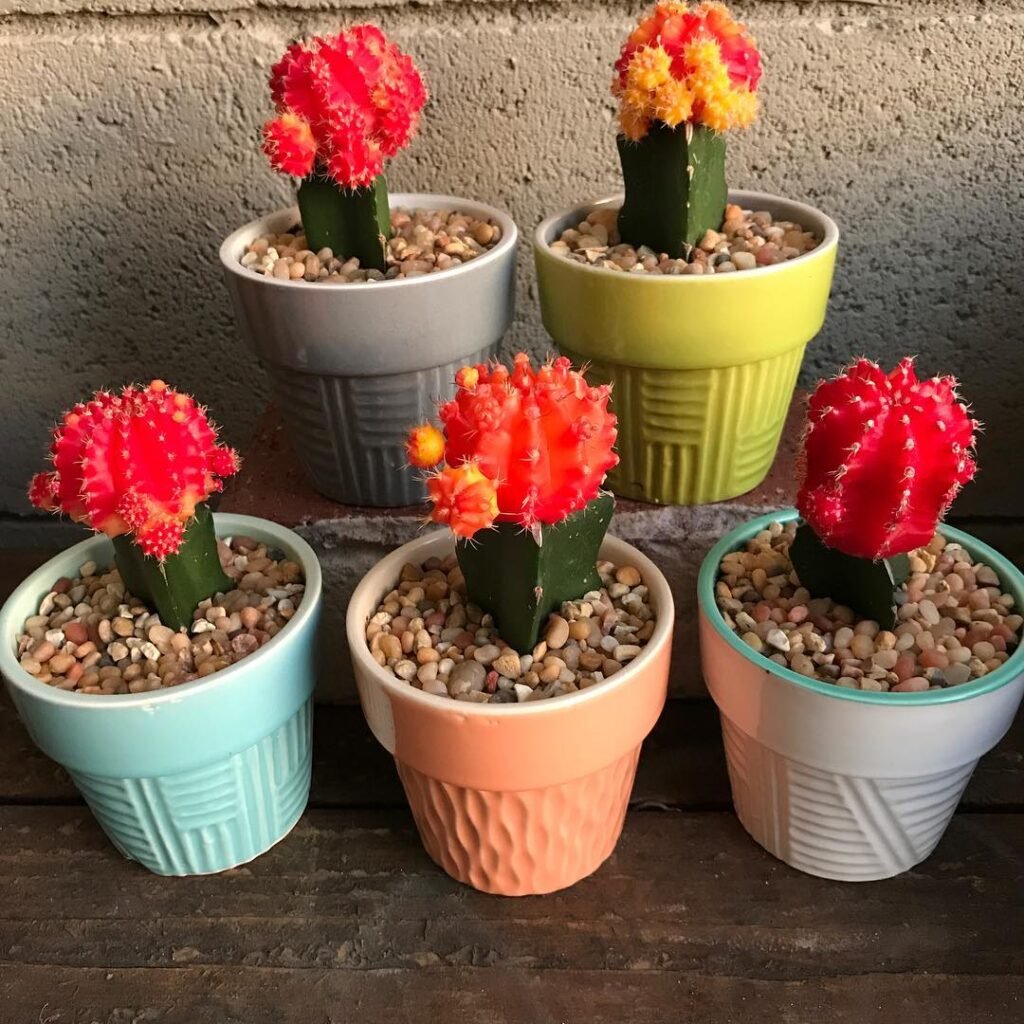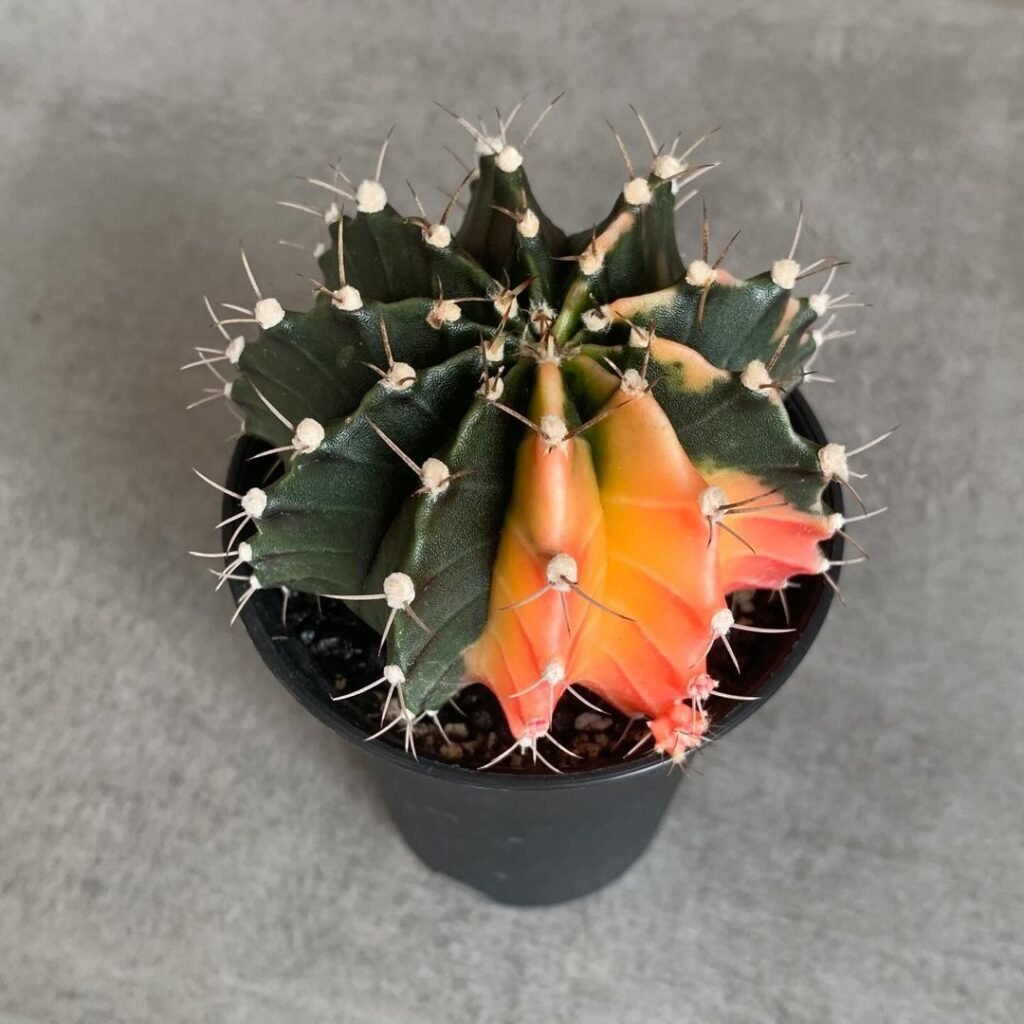The moon cactus is a unique and eye-catching houseplant with a colorful round top globe that looks like it’s from out of this world! But this fun little guy is actually two cacti combined through grafting.
The red, yellow or orange bulbous top is a type of cactus without chlorophyll called Gymnocalycium mihanovichii. Since it can’t produce its own energy from sunlight, it’s grafted onto a green cactus understock like Hylocereus or Myrtillocactus that can support it.

With the right care, these grafted cacti can live for years inside as neat low-maintenance houseplants. Here’s a simple guide to growing and caring for moon cactus plants.
What Moon Cactus Needs to Survive
Light
The colored globe part does best with bright, filtered light or some shade from hot direct sun. Too much intense sun can cause the “moon” to sunburn and turn reddish-brown.
The green cactus understock needs as much sun as possible to photosynthesize and feed both parts of the plant. A bright, sunny window or supplemental grow lights work well.
Water
Moon cacti are succulents, so they store water in their fleshy bodies and do best when the soil partially dries between waterings. The top globe part especially rots easily if overwatered.
In general, water thoroughly when the soil is mostly dry, then let it drain fully and don’t water again until the top inch or two of soil is dry. During winter months, only water enough to keep the plant from completely shriveling.
Soil
These grafted cacti want a well-draining potting mix designed for cacti and succulents. Regular potting soil holds too much moisture and causes rot. Cactus/succulent mixes have extra gritty ingredients like perlite or coarse sand.
You can also make your own well-draining mix by combining:
- 1 part potting mix
- 1 part small gravel or crushed rock
- 1 part coarse sand or perlite
Temperature
Moon cactus do best in the same warm temperatures that we keep our homes – between 65°F to 85°F during the day. They can tolerate temperatures down to around 50°F at night in winter.
Avoid extreme heat over 90°F or freezing cold below 40°F, as this can damage or kill the plant. Also keep them away from drafts, heating vents, and air conditioning units.
Humidity
Average household humidity around 40% is just fine. These cacti evolved to live in very dry, arid desert conditions.
If your indoor air is extremely dry in winter from heating, you can set the potted plant on a pebble tray or mist the top globe with a spray bottle occasionally.
7 Reasons Your Cactus is Turning Yellow and How to Fix It
Moon Cactus Repotting & Potting

Pots
Moon cactus plants have small root systems, so choose a pot with drainage holes that’s only 1-2 inches wider in diameter than the body of the plant. Excess potting mix holds too much moisture around the roots.
An unglazed clay pot with a single drainage hole works perfectly to help excess moisture evaporate out. Plastic, glazed ceramic, and metal containers retain more dampness.
When to Repot
Only repot moon cactus plants every 2-3 years in early spring and only upsize one pot diameter at a time. Repotting more frequently or moving to too big of a pot promotes rot and stunts growth.
To repot:
- Gently remove cactus by gripping the understock base with one hand and squeezing the sides of the pot to loosen the rootball.
- Discard old soil and trim away any rotten or dead roots.
- Fill new pot 1/3 with fresh cactus mix, set the rootball on top, then backfill around the sides leaving the top half of the understock exposed.
- Gently tamp down and water well, allowing full drainage.
- Don’t water again for at least a week to let any roots that were damaged callus over and seal.
How to Make Your Christmas Cactus Bloom
Moon Cactus Pruning & Grooming
Pruning isn’t really needed other than removing dead or dying sections of the plant. Use clean, sharp scissors or pruners to cut off the discolored parts at the base.
If the top colored “moon” part starts looking elongated and growing upwards instead of remaining round, that means it needs even more sunlight.
The grafted moon cactus tops don’t produce offshoots or “pups.” Any small growths sprouting from the understock base can be trimmed off with clean, sterile cutters if desired.
To discourage outward growth of the understock (which looks unsightly), you can wrap the top third of it in aluminum foil. This blocks sunlight so the understock cactus remains a slender trunk rather than spreading growth.
Boobie Cactus: A Comprehensive Guide
Moon Cactus Troubleshooting
If cared for properly, moon cactus plants can live for decades! Here are some common issues and tips to keep yours healthy.

Shriveling
If the globe top or green understock base starts looking deflated and wrinkly, it means the plant needs more water. Make sure to water thoroughly until excess moisture drains out the bottom.
Etiolation
When the moon cactus leans towards the light source and the colored upper portion starts growing tall and cylindrical rather than round and plump, it means it needs more sunlight. Move to a brighter spot or add supplemental grow lights.
Root
Rot Rotten, mushy roots are a sign of overwatering or poor drainage. Let the plant completely dry out until you can carefully remove it and replant in fresh, well-draining soil after trimming away any rotted roots.
Understock Spreading
If the green cactus understock starts getting wider at the base and sprouting new growth, it’s getting too much light and “reverting” back to its natural form. You can wrap the top third in aluminum foil to stop this.
Unstable Topgrowth
The colored moon cactus top is unstable without the understock to support it and produce nutrients. If the top starts flopping over, turns brown, or detaches completely, the understock is likely failing from improper care.
Re-graft Tops
You can carefully detach the moon top from the old sickly understock and reattach it to a new, healthy green cactus understock using cactus grafting techniques. It takes some practice, but extends the lifespan.
With their low maintenance and unusual look, these fun grafted cacti plants are easy to grow indoors. Just stick to the Goldilocks watering schedule of “not too wet or not too dry” and provide bright light, well-draining soil and the right size pot. Your moon cactus with its wild colors will be the star of your houseplant collection!
Pingback: Types of Hickory Nuts – Identification Guide -
Pingback: 20 Types of Yucca Plants (With Pictures) -
Pingback: 22 Trees With Heart-Shaped Leaves That Will Steal Your Heart
Pingback: Moon Cactus Care Guide (Gymnocalycium Mihanovic...
Pingback: Philodendron Gigas: The Jurassic Monster Plant -
Pingback: Winter Wonderland at Home: 17 Blooming Houseplants for All-Year Color
Pingback: Growing San Pedro Cactus: A Comprehensive Guide
Pingback: Blooming Beauties: 20 Flowers That Start with E - Gardener's School
Pingback: Boobie Cactus : A Comprehensive Guide - Gardener's School